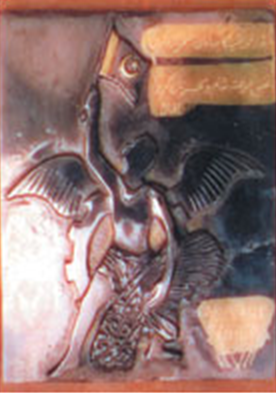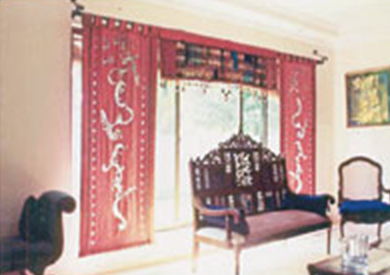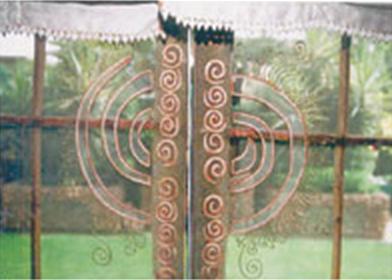Ahmed Saeed Nagi (1916-2006)
This is a collection of articles archived for the excellence of their content. Readers will be able to edit existing articles and post new articles directly |
Ahmed Saeed Nagi (1916-2006)
Nagi is no more
By Murtaza Razvi
In the passing of Ahmed Saeed Nagi (1916-2006), Karachi has lost the last of the eccentric artists who came here and made the city their home. That Nagi Sahib, despite his advanced years, managed to outlive his peers in the artistic fraternity owed much to his untiring zest for life. February 2, his birthday, used to be an annual event at his Jheel Park residence, which had also served as the launching pad for many, now known and forgotten, artists. Following independence, they came from all over, mostly after having sojourned in Lahore. The best known among these were the late Bashir Mirza and Ahmed Parvez, who had followed Ali Imam, Guljee and Jamil Naqsh in their footsteps.
For years after independence, the studio-cum-residence of Nagi Sahib, located in the vicinity of the then American embassy in Pakistan’s emerging capital, Karachi, also served as a social pad, bringing together writers, intellectuals, journalists, politicians and bureaucrats of all hues. No other artist enjoyed the kind of social circle, and influence, that Nagi Sahib did throughout the 1950s, the 60s and the 70s. Alys and Faiz and Begum and Col Majeed Malik were among his work’s admirers. The who’s who of Pakistan was in and out of his house, with the regulars including ministers, chief secretaries, ambassadors and then budding politicians — Z.A. Bhutto being the most prominent among the last mentioned.
Flamboyant, extravagant, indiscreet, at times pompous and even decadent, Nagi Sahib may have been all of these by turns; what he was not was mean or hypocritical. Above all, he was a very generous man thrown in the midst of what turned out to be a bunch of opportunists among his peers. Many used him and his clout for getting introduced to the ‘right’ crowd; others went on to win recognition as big names on the art scene, with or without acquiring formal academic training, and to denounce Nagi’s work as that of a half-baked craftsman and not a painter. But he did not hold such people’s fame and recognition against them, and kept being open to exploitation by more and more hitherto unknown artists who sought ‘shelter’ and advice from him in their formative years in the new city. Nor did he use his contacts for seeking self-aggrandisement and financial benefits.
In his last years, the artist’s home in what became PECHS stood as testimony to his old-world, easy-going disposition. The crowd that even now descended on his house for the annual birthday bash included few remaining old friends, retired bureaucrats, an odd diplomat, worn-out socialites, wannabe painters and a few middle-class writers looking for a watery groove. True to form, Nagi Sahib decked up in his 1950s’ Paris complet, worn with a maroon or purple bow tie, would wave at them, thanking them for holding the party to honour him on a ‘bring-your-own-bottle’ basis. Of course there were many whom he forbade from bringing their own refreshments, saying ‘Friends of Nagi’ would take care of them. The only time he did not celebrate his birthday was in 2004, when three weeks earlier his dear friend Syed Abid Ali Shah had breathed his last in Islamabad.
Nagi Sahib’s formative years in particular were spent in the old, fabled past, when you still heard of a few remaining, even if not conspicuous, Mughal princesses. His own grandmother was one, whose life as a child was saved only by making a timely escape to Nepal at the time of the arrest and forced exile of the last Mughal ruler Bahadur Shah Zafar. Years later she managed to make her way back into India, opting for an anonymous life in a Lucknow suburb before meeting her future husband, a civil servant from Amritsar. Much later, Nagi’s mother was to marry a civil engineer, and Nagi was born at his grandparents’ ancestral home. That day the family’s pirs had arrived out of the blue, bringing it tidings of the arrival of a gifted boy, whom they named Ahmed.
Flamboyant, extravagant, indiscreet, at times pompous and even decadent, Nagi Sahib may have been all of these by turns; what he was not was mean or hypocritical. Above all, he was a very generous man thrown in the midst of what turned out to be a bunch of opportunists among his peers
Nagi recalled with pride his early years as a boy in Delhi’s Jahan Ara Club, in Simla and in Lahore. The Lt-Governor of Punjab once rode an elephant along with his four-year-old sister through Old Anarkali, which was a matter of immense pride for the whole family; little Nagi and his father had walked along. Then the family moved to Khairpur in Sindh, where Nagi had his first brush with painting. As a little boy he used to go to a nearby pond where the gypsy girls bathed in murky, warm waters in their birthday suits. Giggling, some would pose for him as he doodled on a paper, drawing them. The fascination with the genre followed him into adulthood; the artist’s Jheel Park studio was the place where many a female celebrity came to pose for him.
As a young man, Nagi returned to Amritsar in the mid-1930s. Here he kept company with Dr M.D. Taseer, Faiz Sahib and their regular visitors, among them Maulana Abul Kalam Azad and Sufi Ghulam Mustafa Tabassum. The maulana, he said, would only drink one certain kind of beer, considering the rest of them ‘haraam’. “It was my duty to go and fetch that brand from the Amritsar railway station, the only place where you could find it. The damn thing was a higher-volume beverage than the average beer as I later discovered,” Nagi would narrate, laughing.
It was also young Nagi’s duty to fetch kulchas (flat Kashmiri bread with sesame seeds on it) and siri-paya curry for Taseer and Faiz for the Sunday brunch, with the condition that he would only go to the tanoor in town where Sufi Tabassum, on his weekly trip home from Government College, Lahore, used to bake the kulchas himself. “They told me to stand there and wait for Sufi Sahib to finish his baking for the day and then bring him along on a tonga for brunch.”
These and many such anecdotes belonged to a distanced, fabled past, but Nagi’s memory refused to fade, as he counted his losses. Back in Karachi, twice, the studio was broken into and the paintings stolen in the 1980s and ’90s. A few portraits, a series depicting wine and goblet titled ‘Saqi Nama’ and a few studies of girls from different parts of the country, however, survived the thefts, besides those salvaged by friends in their homes as personal collections. Nagi Sahib wanted to present what remained of his work to a museum or a gallery in Karachi, if only they would make room for it. But that was not to be, even though the painter pleaded with the Sindh archives, the government and a former corps commander.
He was reluctant for his works to be transferred to a far off gallery in another city where he would not be able to see them again. He said the response given to his pleas broke his heart; he was told point-blank that because he did not belong to Sindh, they could not justify creating space for his works at a museum funded by the provincial government.
This, he believed, was only a lame excuse. The real reason was something else, and credibly so. Some of his peers among the art fraternity who had gone on to qualify as academics had ruled that Nagi was not a painter; his work did not deserve to be treated, much less acknowledged, as painting. “Mere saare kabootar udd gai,” he used to say in chaste Punjabi in his waning days (all my pigeons have flown away). The euphemism stood for girls who used to model for him to be painted from life, shedding their silks and chiffons for him.
So fond was he of beautiful girls that once at the Boat Club and reminiscing about his work as a decorator of Pakistan’s missions and trade stalls abroad, he found himself totally distracted by three well-dressed middle-aged women who had just walked in. Hard of sight, he was only able to survey them fully when they walked past his table. “Chhado ji maaiyaan ne” (out with them, they’re old), he quipped. On another occasion when he was invited for refreshments at a friend’s house, he enquired as to the company the friend had gathered around him. When told the names of a few aged gentlemen, Nagi Sahib excused himself, saying: “Ennhaan buddhayaan vich saada ki kam?” (where will I fit in among the oldies?).
His heart ached for Karachi. “I can’t make much out because of bad eyesight, but it feels like this city has grown too old, too soon. I feel as if Karachi is crumbling. Please tell me I am wrong,” he had pleaded the last time we met and drove out, about a year ago.
“The night is still young, what are you talking about?” I told him, evading the question. The cheer that it brought to his face was one you saw on the face of a boy after he sees his first nude picture.


